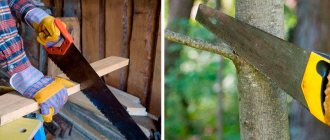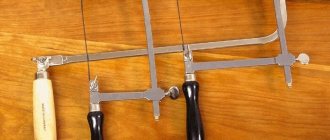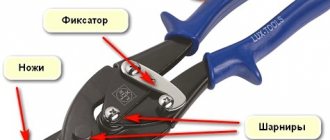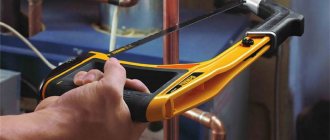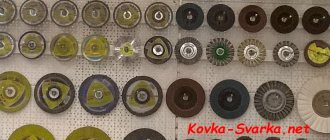A blade for a hacksaw for metal is one of the most short-lived elements from the entire range of consumables for tools. Of course, a lot depends on the technology of working with metal and the skills of using a hacksaw, but first of all you need to be able to make the right choice of blade. Today, we will talk about the choice and types, and also learn how to easily change the hacksaw blade.
Types of hacksaw blades
GOST R 53411-2009 “Hacksaw blades for metal” establishes two types of such tools - for machine and manual cutting. We won’t touch on the former, but the latter are available in three main sizes:
- Single, with a distance between fastening holes of 250±2 mm, with a total length of the blade of no more than 265 mm;
- Single, with a distance between fastening holes of 300±2 mm, with a total length of the blade no more than 315 mm;
- Double, with a distance between mounting holes of 300±2 mm, with a total length of the blade of no more than 315 mm.
At the same time, the thickness of the blade s for a single version is 0.63 mm, for a double version – 0.80 mm. The height with a single row of teeth is 12.5 mm, and with a double row it is 20 mm.
GOST also regulates the values of the tooth pitch P, mm and their number z, which for blades of the first type are 0.80/32, 1.00/24 and 1.25/20, respectively. Owners of longer hacksaws, in addition to those listed above, can also use hacksaw blades with parameters 1.40/18 and 1.60/16.
According to the grade of material used for the manufacture of blades for hacksaws for metal, they are made from tool steels:
- Brands X6VF.
- Brands V2F.
- High-speed, grades P6M5, P12 or P18.
The range of domestically produced hacksaw blades is limited to this, however, in specialized retail chains, so-called diamond blades, surface-sprayed with titanium nitrides or other refractory metals, are widespread. Such blades can be easily distinguished by color: regular steel blades are dark gray, while sprayed steel blades can have different colors - from bright orange to blue (depending on the manufacturer).
There are also blades with so-called tungsten carbide coating, however, with very high hardness, they are extremely sensitive to bending stresses. Therefore, when cutting metal, their durability is negligible.
The high strength of blades for hacksaws for metal is ensured by appropriate heat treatment. On the surface of the blade, two zones with different hardness values are distinguished: directly at the teeth it ranges from HRC 64...67 for alloy tool steels to HRC 73...78 for high-speed steels (for diamond blades this parameter reaches HRA 82...84), and in the rest zone - HRC 44...46. A significant difference in hardness confirms the high sensitivity of the product to bending stresses, therefore the standard also limits the maximum force applied to a hand saw. It should not exceed 60 kg when working with blades with a tooth pitch of less than 1.4 mm, and 10 kg for blades with a tooth pitch of more than 1.4 mm.
Types of hacksaws
First of all, hacksaw blades differ from each other in their shape, as well as in their purpose. One hacksaw is designed to work with hard materials, others with metal, and others with various types of wood. For this reason, in the selection process it is necessary to focus on the material being processed.
Hacksaws are available for machines or hand jobs. The difference is in the hardness of the teeth, which you should pay attention to when working with steel materials or steel of increased hardness. These hacksaws are heat-treated and contain about 1% carbon.
Hand saws
Steel with a length of two hundred and fifty to three hundred millimeters. Unhardened and low carbon steel is used. The blade can have teeth of different sizes, which increases the hardness index.
Mechanical hacksaws are made up to four hundred millimeters long and 25-55 millimeters wide.
Principles for choosing canvas
The selection criteria are:
- A type of hand hacksaw for metal, or more precisely, the distance between the mounting holes. It is better if it is changeable, then a hacksaw blade of any size will be suitable for the job.
- The tensile strength of the metal being cut. If the tool is supposed to be used to separate soft, ductile metals - copper, aluminum, etc., then it is advisable to have a hacksaw blade with the least hardness. The material can be steel Kh6VF; Imported canvases have the designation HCS on the side plane. For cutting stronger metals, blades made of high-speed steels (corresponding import marking - HSS) are suitable.
- The thickness of the metal being cut and the quality of the cutting surface. Foreign practice recommends using the PPI parameter as a selection criterion - the number of tooth vertices per inch of blade length. Thus, for thin metals, where it is required to obtain a very smooth cut surface, a PPI value of >24 is considered correct. If productivity is more important to the user than quality, then PPI should be
Hacksaw blade: classification, features of use.
To saw different materials, blades of different structures are required: with large and small teeth, made of carbon or hardened steel, with routing only along the teeth or along the entire length of the blade.
A hacksaw is used to cut metal and wood blanks, plastic and drywall, and different hacksaw blades are used to work with different materials.
Thus, the wood blade used for sawing boards, chipboards, and logs is very wide and has large teeth.
The metal blade is much narrower, with fine teeth; it is used in a suitable hacksaw.
In a hacksaw for metal, the degree of tension of the file is adjusted, which is adjusted to work with both soft and hard alloys, as well as non-metallic materials, for example, plastic, etc.
The cutting element of a hacksaw for stone, or more precisely, for concrete, is similar to a wood saw, but with much larger teeth.
Carbide metal is soldered onto individual teeth in order to saw, in addition to dense concrete, also foam concrete.
Tungsten carbide coated blades
There are hacksaws with a flat metal base and “ropes”. The former are needed when working with such types of materials as glass, ceramics, and porcelain.
Types of hacksaw blades
Blades for working with metal have their own purpose for different alloys, differing in their characteristics, the thickness of the material being cut and the volume of work to be done.
The expected scope of work divides the tool into 2 types.
• A hand tool – a hacksaw – cuts metal through the application of physical effort.
In this case, it is possible to saw a relatively small amount of material.
Accordingly, the blade is not designed for long-term loads and is made of carbon steel.
A blade for a manual jigsaw is always cheaper, but it is harder to work with.
Hand hacksaws can be both professional and household.
The blades, accordingly, can be either more durable - hardened, for example, blades for a sparta hacksaw for metal - or less reliable.
The difference between them is due to the ability to maintain the sharpness of the teeth during prolonged use.
The best hacksaws for wood
The wood hacksaw has a large tooth with a three-sided sharpening. And this is ideal. Many manufacturers ignore this aspect and sharpen the teeth only on both sides. It is possible to work with such a tool, but the cutting time increases significantly, since the blade deepens only when moving in one direction. The best wood hacksaws cut both forward and backward. Such saws are more expensive, but they are more convenient to work with, especially if the blade is made of high-quality steel that will not dull quickly.
Canvas dimensions, length, width
The dimensions of the file are determined by the fastening method.
— Most models provide double-sided fastening.
For such products, canvases are available in only 2 sizes: 300 and 150 mm.
The first option is considered standard; products of this size are made of all possible types and from all acceptable materials.
The 150 mm long file is made only of carbon steel.
The thickness depends on the purpose of the tool.
On professional models, the value varies from 0.63 to 1.25 mm.
Blades for electric saws are thick - up to 2.5 mm.
— Blades for hacksaws, where fastening is only on one side, are made in lengths of 220 and 260 mm.
The height of the file reaches 13 mm. They are made only from a bimetallic alloy, since all other options are too fragile.
— For products with a pistol grip, blades can be of different lengths and thicknesses.
They are made only from bimetallic alloy.
Another important characteristic is the tooth.
Products with fine teeth are suitable for sawing hard metals.
The option with large ones is intended for processing soft ones.
They are not interchangeable.
Since when sawing soft metals with small teeth, the saw quickly becomes clogged with shavings, and the cut turns out to be sloppy and torn.
Carbon steel blades
They are the least resistant. Quality depends significantly on production technology, primarily on heat treatment. For the most part, carbon steel blades can only be used for work on soft, annealed steels and non-ferrous metals.
There are also similar metal-cutting tools (blades) made of cold-rolled steel strip, the teeth of which are hardened by high-frequency currents. Usually they are suitable only for work on soft non-ferrous metals and less durable materials (wood, plastic and composites based on them).
Recommendations
To select the appropriate tool, consider the following parameters:
• size – determined by the volume of work.
Compact products with a length of 150 mm are suitable for sawing small amounts of materials, since the hand gets tired quite quickly when working with such a jigsaw.
Standard saws with a length of 300 mm perform more work;
• tooth shape and sharpness;
• pitch – for sawing soft alloys, plastics, asbestos, large teeth with a pitch of 18 are suitable.
Hard materials are cut with fine-toothed hacksaws;
• material – the most durable and reliable today is a cloth made of different metals, the so-called bimetallic.
But if a blade is rarely needed, then the home craftsman can get by with a carbon steel model;
• cost – the nature of the fabric, the size and configuration of the teeth determines the price of the product.
Best Custom Hacksaws
Non-standard hacksaws can cut not only metal or wood, but also other materials, such as laminite or foam concrete. The difference lies not only in the shape and configuration of the blade, but also in the shaper of the saw itself. For example, to cut laminate, a triangular blade with a very small and very frequent tooth is used. This allows you to cut without chips or other errors. There are also more exotic tools, for example, designed specifically for cutting branches from trees. There are quite a lot of similar designs on the market, so we settled on the five most interesting options.
Rating of hacksaw blades
According to consumer demand, the rating of the most successful models includes the following:
• Bahco is a Swedish company that offers a wide variety of tools. Sandflex bimetallic sheet is rightfully considered the best.
Its purpose is to cut metal, plastic, and composite materials.
The latter are usually the most difficult to process, since different layers of such a product have different hardness and strength.
• Topex - the blade is made of hardened steel and is much more affordable than a bimetallic alloy.
Although it is inferior in durability to the previous option, it is quite suitable as a home tool.
It cuts metal alloys, plastic, and can work with ceramics, but not porcelain stoneware.
• Stanley – bimetallic files from this manufacturer are considered the best.
Exceptional flexibility of the fabric and strength guarantee a long service life.
It cuts the hardest metals, but only with the correct choice of tooth pitch.
• Anchor “osa” is another manufacturer of hardened steel blades.
The teeth remain sharp for a long time; cutting at right angles and at an angle of 45 degrees is allowed.
A hacksaw is considered a fairly common hand tool, which is designed to divide a workpiece into several separate parts of a certain size. Its design features are characterized by the fact that it is possible to periodically replace the worker. When processing metal, there is a very high probability of rapid wear of the cutting edge. Therefore, a function for replacing the tape was provided, which requires a small amount of time. There is simply a huge number of different canvases; let’s look at the features of choice and many other points in more detail.
The best garden hacksaws
A hand saw for pruning garden trees is used by summer residents, owners of personal plots, and personnel of municipal municipal services. A special feature of the design is a small, tapered blade, the shape of which is convenient for use in the branchy crown of trees. The size and shape of the tooth make sawing dry and wet wood equally effective. Some models are equipped with devices for cutting at high heights.
Skrab 28154
Garden saw for processing tree crowns. Equipped with a lightweight, durable telescopic aluminum rod that extends up to 5 meters. The pole saw is equipped with a hook that limits slipping, allowing you to quickly and accurately saw off a branch at a great height. The handle is rubberized, made of anti-slip material and provides a comfortable grip. According to user reviews, its shape reduces the load on the hand when working without a barbell.
The blade is made from hardened tool steel, resistant to wear. Protective anti-corrosion coating prolongs service life. The teeth with variable pitch are sharpened and easily cope with branches with a diameter of 10-15 cm. High quality steel stabilizes the quality of the cut. This allows you to do without additional wiring and sharpening.
Advantages:
- Light weight;
- It is convenient to work among branches;
- Blade protection cover;
- Free return.
Flaws:
- Soft metal limiters.
Grinda 8-151853
The model is designed for routine maintenance of garden trees. It has an ergonomic curved handle, the shape of which simplifies sawing in cramped conditions. The handle is made of two-component plastic, does not slip, does not rub during intensive use. There is a hole for hanging storage.
The 30 cm long blade is made of carbon steel and has a chrome-plated surface that is resistant to corrosion. Reverse bevel teeth are designed for cutting dry and wet branches. Induction hardening and triangular sharpening ensure high performance. Supplied with a plastic sheath with belt mounts.
Advantages:
- Good at sawing workpieces of various types;
- Long service life;
- No constant sharpening required;
- Sawing effortlessly.
Flaws:
- Not detected.
Opinel №12
The world-famous French knife manufacturer produces the best garden saws. Wear-resistant tool steel with increased strength, 1 mm thick, is used for production. The model has a folding design, which makes it relevant for summer residents and tourists. It is equipped with a vibrating locking ring that protects against accidental folding and serious injuries.
The fine, double-pointed tooth effectively cuts through dry and damp wood. The “pull” working movement allows you to reduce physical stress on the user. The handle is made of beech wood and is highly durable and resistant to shock loads. The shape of the handle takes into account the specific anatomy of the user's palm.
Advantages:
- Long service life;
- Reliable folding mechanism;
- No regular sharpening required;
- Copes well with branches of any thickness.
Flaws:
- High price.
Types of hacksaw blades and their design
Do not forget that the production of working hacksaw blades is carried out in accordance with established standards in GOST 53411-2009. The specified information in this regulatory and technical documentation determines the identification of two main groups: for machine and manual cutting. It is worth considering that a machine hacksaw blade for metal is purchased extremely rarely, since such equipment is used extremely rarely. The following versions are produced for a manual hacksaw:
- Single hacksaw blade for metal with a distance between fasteners of 250 mm. In this case, the total length is 265 mm. This design option is suitable for a tool that is used when there is no need for high productivity.
- Single versions with a distance between two fasteners of 300 mm. The overall length is 315 mm.
- For greater productivity, a double hacksaw blade is installed. The length of this version is the same as the previous one.
When choosing, attention is paid to the width indicator, which for a single version is 0.63 mm, for a double version 0.8 mm. The height of the tooth in the first case is 12.5 mm, in the second 20 mm.
The value of the location step is also regulated, since such an indicator determines many operational characteristics.
In the manufacture of such a product, a variety of alloys can be used, on which the main performance characteristics largely depend. The most common alloys are:
- X6VF.
- V2F.
- High-speed alloys, for example, R5M5 and R12.
Hacksaw blades coated with tungsten carbide have recently become quite common, as they are characterized by increased wear resistance. It is worth considering that spraying can have a wide variety of colors; blue versions are available on sale; regular steel is dark gray.
The tungsten hacksaw blade under consideration is characterized by the fact that, with a high hardness of the working surface, the structure is characterized by high sensitivity to bending load. That is why, if metal is cut carelessly, such a product will not last long.
Manufacturers can achieve high strength through heat treatment. It is worth considering the following:
- The main part of the product is characterized by a surface layer hardness of about HRC 44-46.
- Depending on the type of material used in manufacturing, tooth hardness varies within the HRC limit from 64 to 67. This indicator is characteristic of alloyed alloys. High speed steel is characterized by having an HRC hardness in the range of 73-78 units.
Do not forget that significant changes in hardness cause the product to be sensitive to bending. The tool is designed for varying loads, it should not exceed 60 kg with a tooth pitch of 1.4 mm, and 10 kg with a tooth pitch of less than 1.4 mm.
A fairly large number of varieties of such a product determines that there are no serious problems with the selection of a suitable version.
Principles for choosing canvas
It is important to correctly select the most suitable version of the product for specific operating conditions. If the surface does not have the required properties, it will not last for a long period. The selection criteria include the following points:
- The most important selection criterion is the distance between the two mounting holes. For some instruments, this indicator may change due to a special device.
- The next selection criterion is the strength of the metal being cut. If the work involves cutting common soft alloys, for example, copper or aluminum, then a product with the lowest hardness of the surface layer is selected. Kh6VF steel is very common; for paintings of imported origin, the HCS marking is used. It is also possible to process durable metals, for which a high-speed steel hacksaw blade is suitable, imported HSS marking,
- The thickness of the metal being cut and the quality that needs to be achieved after processing are also taken into account. Abroad, the determining criterion is the PPI indicator - the number of tooth tips per inch of length. To ensure high quality, a PPI of more than 24 is required; if performance is a priority, then a design option with an indicator of less than 24 is selected.
- When choosing, attention is paid to the quality of the cutting edge spread. This parameter must comply with the standards established in the previously cited GOST. There are three main options: dilution for each, through one tooth or two adjacent ones.
Product classification
Hacksaw blades are a narrow strip, at the ends of which there are two holes for attaching to the tool. There are three main criteria for their classification:
- purpose (for hand/electric hacksaws);
- material of manufacture;
- teeth parameters.
The division into groups according to the first criterion occurs like hacksaws - there are blades for manual (mechanical) and electric (sometimes called machine) tools. The dimensions of the working elements vary. So, for manual ones, canvases with a length of 250-300 mm, a width of 12-25 mm, and a thickness of 0.63-1.25 mm are used. An example is a domestically produced blade made of Kh6VF steel with parameters 1.25x12x300, which will cost the buyer 30 rubles per piece.
The parameters of files for power tools vary from 150 mm in length, to 55 mm in width, from 1.25 to 2.5 mm in thickness. An example is a blade for a reciprocating saw HAMMER RS BL 001, the parameters of which are 150x19x1.25 mm, and the cost is 100 rubles per piece.
Another difference between saw blades for hand and reciprocating saws is the number of holes for fastening. The first ones have two, the second ones have one.
- carbon (the least durable, suitable for non-ferrous or soft metal; marked as HCS); for example, Bosch HCS TF 350 M 408 mm GFZ for 1400 rubles;
- high-speed (they have the most wear-resistant teeth, but are fragile and high in price; HSS marking); Gross HSS 18TPI 300 mm - 160 rubles per pair;
- bimetallic blades (an innovation on the market that is displacing analogues; the base is carbon steel, on top of which a high-speed strip is welded, serving as the basis for the teeth; designated BIM); Gross Variozahn 300 mm BIM from 300 rubles per pair.
There are also alloy steel (designated HM), but more often they are used for cutting brick, concrete or stone.
The size of the teeth for hacksaws for metal is 2-2.5 mm. This parameter is considered “small”, since there are products with larger teeth (for example, for wood saws it is 4-6 mm).
International standardization provides for a different principle of dividing the canvases. So, the number of teeth per 1 inch of file is taken into account. This figure is given in the marking before the letters PPI (points per inch) or TPI (formula “PPI - 1”). The higher the number, the smaller the tooth represented on this canvas.
When choosing products for a hacksaw, the user does not have to guess for a long time - most well-known files have a tooth pitch of 18 or 24. This is how branded products for construction are designated (for example, Standart 24 TPI 300 mm, Kraft-Flex 18 TPI blade from the manufacturer Kraftool).
The main classification of blades for metal hacksaws is based on the given criteria. It is important to know that the presence of set teeth is welcome if the user expects comfortable work without pauses or tool breakdowns. Now let’s talk about how to properly install a hacksaw blade in a manual or electric tool.
How to install a blade on a hacksaw for metal
The design of the tool in question allows for quick replacement of the hacksaw blade. It is worth considering that if a mistake is made, the product in question will not last for a long period. How to install a blade in a hacksaw for metal is a very common question, since this tool is found in almost all home workshops. The main recommendations are the following:
- The instructions largely depend on the fastening system used in a particular case.
- The threaded clamp, in which the hacksaw blade is installed and tensioned, has become widespread. A sudden change in the applied load becomes the reason why you have to periodically check the degree of tension.
- There are tools with lever fastening. In this case, installation is greatly simplified, since it is enough to pull back the lever and install the hacksaw blade for cutting metal, and then tighten it in the opposite direction.
When considering how to properly insert a blade into a hacksaw for metal, it should be taken into account that after proper installation it creates a slight ringing sound during operation and may vibrate a little. However, at the time of sawing, the product should not change its position, as this may cause damage to the mounting holes.
Methods for installing the canvas
- threaded clamp;
- lever mechanism.
In the first case, the canvas is stretched between the mounting holes and secured with a wing nut. In the second, the actions are performed similarly, only the file is put on and removed using a special lever, usually located at the edge farthest from the handle.
The blade is installed in such a way that the teeth tilt in the direction opposite to the handle. When using a hacksaw, the metal layer will be cut while moving away from you. The reverse direction - "toward" - is idle, in which the workpiece is not cut. Therefore, efforts during the reverse movement are in vain. In addition, it is so easy to dull the teeth of the blade.
For electric hacksaws, the working part is attached differently. For example, below is the process of replacing the blade on a Makita JR 3070 CT reciprocating saw. To do this you need:
- turn the holder head counterclockwise at a slight angle so that the internal slot allows you to remove the product;
- remove the canvas;
- Place the end of the new file into the slot of the holder until you hear a characteristic click.
By the way, the blades are also divided by the type of shank (the section that connects to the holder). There are shanks with one stop, two-jaw, universal 1/4, clamping 1/2 and special for Makita saws, which have two holes at the end.
The principle of attaching hacksaw blades to reciprocating saws is the same for all devices; The manufacturers thought through the design, made inserting the cutting element convenient and made the user’s work easier.
Selection rules
Subject to certain rules, it is possible to choose a suitable canvas that can last for a long period. The main recommendations are the following:
- The surface should be free of cracks or other defects, as well as traces of corrosion. This is due to the fact that even minor damage will cause increased wear.
- At the time of selection, you should make sure that the saw is elastic. To do this, bend it a little and then release it. A high-quality product almost immediately restores its shape, which indicates high flexibility.
- As previously noted, the permissible cutting speed largely depends on the number of teeth per inch.
- The determining factor in many cases is the type of material used. Often they give preference to hardened steel or bimmetallic products. The version with tungsten carbide coating lasts for a short period.
It is not recommended to use price as the main selection criterion. However, a design that is too cheap fails within a short period.
As practice shows, a low-quality version has to be changed several times, while a more expensive proposal will last for a longer period.
Rules for choosing equipment
- There should be no cracks or signs of corrosion on top of the canvases.
- Make sure the file is elastic. To do this, you need to bend it slightly and release it. A high-quality product will instantly restore its original shape.
- The cutting speed directly depends on the number of teeth per inch. The more there are, the less time the operation will take.
- Among all the files, the one suitable for sawing a particular metal is selected. Preference should be given to red-hot iron or bimetallic products. The first ones look like stainless steel coated with a layer of nickel, but have dark teeth. The latter are painted in a certain color (red, yellow) or several shades. The listed canvases are much more durable than their black counterparts.
- The length of the blade corresponds to the length of the hacksaw, whether we are talking about a manual or electric tool. In order not to make a mistake, it is important to study the markings that are on both the saw and the hacksaw blade.
- You should not consider the price of a product as a key selection factor. A dozen cheap black files (like the Russian Kh6VF 1.25x12x300 mm, 77707 for 30 rubles) will become dull and fail while a more expensive analogue works (for example, Stanley 1-20-437 300 mm long for 120 rubles).
Having made your choice and purchased a metal unit for a hacksaw, all you have to do is secure the equipment and start working. It is also recommended to adhere to the rules for storing and using hacksaw files. Timely replacement of used equipment will extend the service life of hand or electric tools. If you have experience using certain files, share your opinion in the comments.
Source of the article: https://wikimetall.ru/oborudovanie/nozhovochnoe-polotno-po-metallu.html
Recommendations for use
Only with proper use can you eliminate the possibility of damage to the hacksaw blade for metal. The main recommendations are as follows:
- It is necessary to carry out processing at the same speed and applied force. Even minor changes can cause a defect.
- You need to take breaks from time to time. The reasons are that too high a temperature causes an increase in ductility.
- At this point, the entire hacksaw blade must pass over the surface. This ensures even wear.
You can often encounter a situation where, due to strong heat and applied force, a metal plate bursts. Low-quality versions wear out quickly and become practically unusable.
Metal hacksaw blades for sawing tools
It is necessary to consider a hacksaw blade for metal because this type of consumable material is classified into three types:
- For hand hacksaws (they come in large and small). After the advent of angle grinders or grinders, as well as circular saws, reciprocating saws and jigsaws, hand hacksaws lost their popularity, but did not disappear completely
- For machine units - these include band saws that are used in industrial conditions (intended for the machine). For a band saw, blades are used that have the appropriate parameters: length, thickness, material of manufacture, sharpening and shape of the teeth. At home, such units are used only when it is necessary to carry out high-precision cutting of metal parts. For such units, a special belt blade is used, the teeth of which are coated with carbide materials. Band saws use not only equipment for cutting metal, but also wood. Band saw blades require additional water cooling during operation, which extends the service life of the devices and also reduces the load on the drive mechanisms of machine units
- Self-contained electric units are tools that have replaced hand saws. These include reciprocating saws and jigsaws. For reciprocating saws, blades of appropriate shapes and technical parameters are produced. For a jigsaw, blades for metal also have corresponding parameters, so when choosing them, carefully consider what type of tool the cutting consumables are intended for
In this material we will take a closer look at metal cutting blades for a hand saw, which you can buy in any hardware store, on the market, and even in online stores. By the way, the advantage of buying online is that the buyer has greater choice, unlike buying in a store, where the assortment is limited to two or three models.
Number of teeth
The determining factor is how many teeth there are per inch. The following depends on it:
- Performance depends on the indicator. As the number of cutting edges increases, the task at hand becomes significantly more complicated and the chips become smaller.
- A large quantity allows you to get a high-quality cut. This is achieved by reducing the resulting chips.
In addition, an increase in quantity causes an increase in the cost of the product.
Teeth setting
Removal of chips from the cutting zone is carried out due to a certain layout of the cutting edge. As previously noted, according to this criterion, several options are distinguished:
- Wiring for each.
- Setting through one or two teeth.
At the same time, attention is paid to the direction of the teeth. Taking this parameter into account, the plate is installed.
Today, many tool manufacturers specialize in the production of hacksaw blades. At the same time, domestic products are much cheaper, foreign ones are more expensive, but at the same time have higher performance characteristics. For long-term operation, several products are required, as they can wear out at a high rate.
If you find an error, please select a piece of text and press Ctrl+Enter.
Which hacksaw is better
A tool designed for carpentry work is poorly suited for caring for trees, and cannot handle metal workpieces at all. There are no universal models, so the VyborExperta.ru team recommends the following brands, taking into account the scope of application:
- Armero A531/400 – for woodworking in the home workshop;
- Gross Piranha 24111 – the choice of a professional carpenter;
- Vira 801010 – for a locksmith workshop;
- Skrab 28154 – for treating tall trees in the garden;
- Opinel No. 12 – the choice of summer residents and tourists;
- Stanley FatMax is a professional solution for complex tasks.
All the models presented in the review are worthy of buyers’ attention, but only the most reliable, productive and convenient tools were awarded the title of best in their class.
